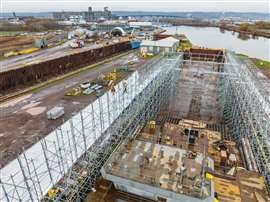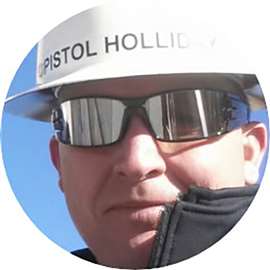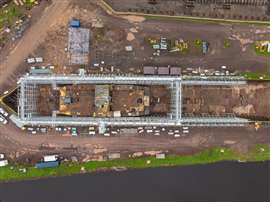Scaffold sharpshooter

Partner Content produced by KHL Content Studio
10 June 2024
For all its technological advances, the basic methods of construction have remained unchanged for hundreds – some might say thousands – of years.
 APi National Scaffold supplies and implements a wide range of scaffold technologies across a number of industry segments
APi National Scaffold supplies and implements a wide range of scaffold technologies across a number of industry segments
Scaffold is one example of this, with examples stretching back to ancient times. To put it bluntly, no scaffold means no construction – at least not at height.
And while we have seen a number of truly innovative scaffold systems come onto the market in recent years, these tend to be designed for very specific construction applications.
For more straightforward construction projects, today’s scaffold is more or less identical to that used in the last century.
What has changed, however, is the demand for greater on-site safety, along with the need to progress projects quickly and efficiently, while keeping costs in check.
It’s for this reason that scaffold experts are as essential on site as the scaffold itself.
 APi National Scaffold supplied state-of-the-art scaffold for a major project at Fraser Shipyards in Superior, Wisconsin
APi National Scaffold supplied state-of-the-art scaffold for a major project at Fraser Shipyards in Superior, Wisconsin
With this in mind, a name that reverberates around the North American scaffold industry is Pistol Holliday, senior scaffold superintendent with APi Group’s National Scaffold division.
Safety top to bottom
With some 30 years’ experience, he is the first to admit that his is a largely traditional craft.
“There hasn’t been a huge amount of change in the scaffold systems themselves,” he says, “but we have seen lots of change in terms of safety. Safety and scaffold now have to go hand in hand.
“You can do everything right, but it’s still a dangerous job. You just have to move ahead systematically and follow procedures and you significantly increase those safety margins.
“In fact, I don’t generally worry about my people hurting themselves; I worry about something else hurting them. It’s generally a chain reaction, where two or three things go wrong, then we have a problem.
 Safety protocols - especially tying off - are key to National Scaffold’s impressive record
Safety protocols - especially tying off - are key to National Scaffold’s impressive record
“There are a lot of safety protocols, but the biggest thing for me is tying off. If everyone is tying off, they’re going to be ok. We have to buy into it and we have to hold each other accountable.”
“To reduce risk as much as possible, everybody on the team – and on the project – has to be on board with the safety protocols. And it starts with me; that’s really important.”
Advancing technology
The power sector is where APi’s National Scaffold team has made its name; in what Pistol calls the bread-and-butter projects, including a number in the nuclear sector. Other strong industries for the company include working on government and military installations.
Some of these projects can be large and complex, but Pistol maintains that “scaffold is scaffold” and is keen to put his team to the test on the largest structures in the country.
 National Scaffold was heavily involved in the decommissioning of the Asbury Power Plant in Missouri
National Scaffold was heavily involved in the decommissioning of the Asbury Power Plant in Missouri
His down-to-earth attitude to the job is infectious. In describing his most challenging project, he recalls a “super big coal burner” saying “Some of the scaffolds were technical, but it’s basically the same thing, only bigger.”
While he sees little change in the on-site aspect of scaffold, Pistol acknowledges that technology is playing an increasing role, both around the structure and off-site.
In the hustle and bustle of the National Scaffold offices, you’ll often find the team diving into the world of BIM (Building Information Modeling) and other 3D modeling systems. They’re not just playing with fancy tech—they’re using it to ensure that every scaffold they put up is spot-on for the job at hand.
Think of it like this: just as those 3D models help predict clashes and make sure buildings are built right the first time, getting the perfect amount of scaffold and the best team on-site is crucial for APi National Scaffold crews to keep things moving smoothly and safely. It’s all about using the right tools and the right people to get the job done right.
Scaffold delivery systems are also changing. “We are seeing a lot of development in access equipment, such as booms and lifts,” says Pistol. “When I first got into the business, I thought there was no way robots would be taking my job. Then here come the booms. It’s actually pretty exciting stuff.”
 Pistol Holliday says National Scaffold is keen to take on more complex projects, such as the Climate Pledge arena in Seattle
Pistol Holliday says National Scaffold is keen to take on more complex projects, such as the Climate Pledge arena in Seattle
While Pistol sees the process of erecting scaffold being a manual job for the foreseeable future, he also appreciates the benefits that technology can bring to a project, both in terms of replacing unnecessary manpower and making projects more efficient.
“If you can get materials to height with a lift, then you should use a lift,” he says. “Lifts don’t get hurt.”
A people business
While autonomous machines and 3D modelling software are playing an increasingly important role in construction, Pistol agrees that people are still the differentiators for scaffold companies seeking to grow their businesses.
“I have a great crew,” he says. “We’ve built a reputation for on-time equipment delivery and a real can-do attitude from our on-site personnel, whether it’s setting up or dismantling.
“All the major contractors know us,” he says. “We’ve worked for some of the biggest general contractors in the world, but we’re now, as a team, looking to step up to the challenge of a megaproject.”
 Pistol Holliday, senior scaffold superintendent with APi Group’s National Scaffold division
Pistol Holliday, senior scaffold superintendent with APi Group’s National Scaffold division
Pistol says National Scaffold’s reputation for customer service will be the key to unlock the next phase of the company’s growth. “It really is the customer service and the on-site skills,” he says, “that differentiate the good from the great”.
He believes his years of experience give him an edge when it comes to taking the measure of a project and putting the right team in place.
“Looking at the whole project is one of my claims to fame,” he says – and when he says that, he means literally looking at it. Whenever the company wins a project, Pistol heads to the site to appraise it, before assembling the team to undertake the work.
It’s a personal service that few companies can compete with, but he sees it as essential, saying, “APi’s difference is really the people, the relationships. As a division of APi Construction, we’re relatively young. We differentiate ourselves by being there for customers and we have a large orgnanization supporting us in that.”
Next-gen scaffold
Pistol also believes getting the combination of scaffold and scaffold team right can save clients time and money. As he says, “The scaffold is the cheap part; it’s the manpower that gets expensive.”
 A birds-eye view of the scaffold in situ at the Fraser shipyards on the shores of Lake Superior
A birds-eye view of the scaffold in situ at the Fraser shipyards on the shores of Lake Superior
That’s probably never been more true than today, with a growing skills shortage, largely brought about by the so-called ‘great retirement’ and a shortage of young people looking to enter the industry.
Pistol doesn’t see the problem being insurmountable. A slogan of APi is Building Great Leaders and Pistol is fully behind the sentiment. “I love seeing people who have grown with me stepping into leadership positions,” he says.
Remembering his own early years in the business, he says, “The old guys kept all that information close, which made it difficult to develop skills. Now we’re open – we’re not hiding anything. We want to tell new members of the team: ‘here’s what you can work toward’.”
And with the backing of APi Construction, with nearly 100 years in business, he has no doubt that he can continue to build skilled teams for any size of project. “If you want to get good hands,” he says, “you’ve got to put a few more dollars on that check and you’ll start pulling talent from across the country. And we do a good job of treating people well.
Pistol’s dynamic personality has already taken National Scaffold to new levels of growth and, with a strategy of developing further through mergers and acquisitions, he feels confident that he can build teams to tackle any project.
“You have to have a dynamic personality,” he says, “to be the guy who can really bring it together – a team mentality.”
His vision for the company – to take the next step into megaprojects – is clear, as is his message for anyone looking for a career in scaffold: “If you’re a hard worker and can build scaffold, I want you on my team”.
Scaffold tech: the MonZon weather protection systemAPi Construction has partnered with MonZon to exclusively offer its PROTECT IT™ weather protection system in the US. APi National Scaffold leads the way in scaffold design and implementation, leveraging the MonZon PROTECT IT™ system for enhanced safety, build efficiency, and protection from the harsh elements. 
The system was developed by MonZon, in collaboration with a worldwide scaffold group, which identified challenges within the sector, including the requirement for an advanced temporary roofing system, to protect construction teams from the elements. Lightweight, flexible and ergonomic, the system creates a comfortable working environment in all weathers without compromising safety or reducing downtime and subsequently aids the rapid progress of projects. PROTECT IT™ allows for the mounting of asymmetrical/symmetrical, double-pitched/mono-pitched and mansard spans - and contractors can select one or two Keder tarpaulins, tailored to the weather conditions, which can be simply removed, to allow access for machinery or bulky loads. |
--------
All images courtesy APi National Scaffold
--------
This article was produced by KHL’s Content Studio, in partnership with experts from APi National Scaffold
MAGAZINE
NEWSLETTER
The gold standard in market research
Off-Highway Research offers a library of more than 200 regularly updated reports, providing forensic detail on key aspects of the construction equipment industry.
Our detailed insights and expert analyses are used by over 500 of the world’s largest and most successful suppliers, manufacturers and distributers, to inform their strategic plans and deliver profitable growth.








